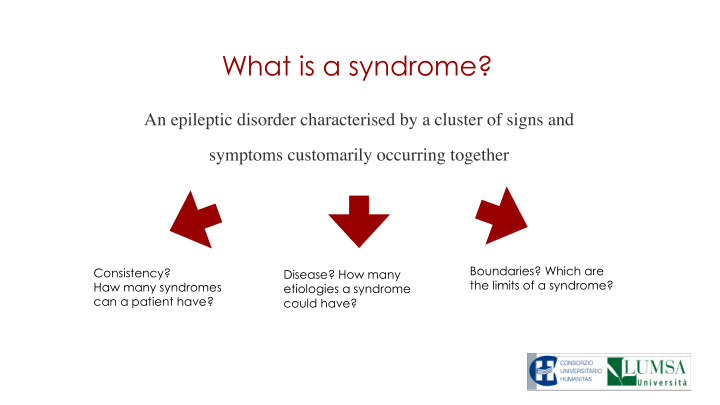



What is a syndrome? An epileptic disorder characterised by a cluster of signs and symptoms customarily occurring together Boundaries? Which are Consistency? Disease? How many the limits of a syndrome? Haw many syndromes etiologies a syndrome can a patient have? could have?
� Generalized Seizures � • Myoclonic jerks • Absence seizures (with few variants) • Generalized Tonic-Clonic Seizures
Idiopathic � Generalized Epilepsies � • Myoclonic Epilepsy in Infancy • Generalized Epilepsies with Febrile Seizures Plus • Epilepsy with Myoclonic Astatic Seizures • Childhood Absence Epilepsy • Epilepsy with Myoclonic Absences • Idiopathic Generalized Epilepsies with Variable Phenotypes Juvenile Absence Epilepsy Juvenile Myoclonic Epilepsy Epilepsy with Generalized Tonic-Clonic Seizures Only (J. ENGEL, 2001)
To treat? What to treat? How much treat? ü Natural course of epileptic syndrome ü Impact of seizures on quality of life ü Percentage of drug resistance in the different syndromes ü Consistency of EEG epileptic activity with cognitive/ behavioral profile
Childhood Absence Epilepsy ( Petit Mal) P.S. F. 12 years; Juvenile Absence Epilepsy Fp2-F4 F4 -C4 C4-P4 Neocortex P4 -O2 F8-T4 T4-T6 T6-O2 Fp1-F3 Thalamus F3 -C3 C3-P3 P3 -O1 F7-T3 T3-T5 T5-O1 Fz-Cz Cz-Pz 100 : V 100 : V Simple absence seizure 1 sec 1 sec Age at onset . 2 - 8 yrs Variable frequency of seizures ( 3-4 to 40-50/ day) VPA, ESM, LTG: : effective in 50 - 90%
Childhood absence epilepsy prognosis ¡ Drug refractoriness does not influence long- term prognosis ¡ More than 90% of patients will remain seizure free after drug discontinuation ¡ The vast majority of patients will achieve seizure freedom before the age of 20 years Livingston et al, 1965; Headstrom & Olsson, 1991
Juvenile Myoclonic Epilepsy ¡ � Idiopathic � i.e. genetically determined epilepsy ¡ Polygenetic ¡ Age-related onset ¡ � Generalised � i.e. with a bilateral quasi-symmetric and synchronous ictogenesis ¡ Three possible seizure types ¡ Myoclonic (100% per definition) ¡ GTCS on awaking (most) ¡ Absences (minority) ¡ Onset with any of these types
EPILESSIE FOCALI IDIOPATICHE FORME 1. Epilessia benigna dell’Infanzia con parossismi centro-temporali (Epilessia Rolandica) 2. Epilessia occipitale con crisi con segni autonomici (Sindrome di Panayiotopoulos) 3. Epilessia focale occipitale idiopatica CARATTERISTICHE GENERALI (Gastaut) - 22% delle epilessie in età pediatrica - Sviluppo psicomotorio normale - RM encefalo nella norma - Epilessie età-dipendenti con scomparsa delle crisi in età adolescenziale nella maggior parte dei casi
EPILESSIE FOCALI IDIOPATICHE Benign childhood partial seizures with focal EEG sharp-slow wave complexes may be a group of syndromes that are linked together due to a common, genetically determined, mild and reversible, functional derangement of the brain cortical maturational process that is called “ benign childhood seizure susceptibility syndrome ” . This is often clinically silent, manifested in more than 90 per cent with EEG sharp and slow waves with an age related-localization. In the remaining minority, there are infrequent partial seizures of which their symptoms also are localization and age-related and dependent. Panayiotopoulos P., Epileptic Syndromes in infancy, childhood and adolescence, Chapter 15, 2002
SINDROME DI PANAYIOTOPOULOS CARATTERISTICHE delle CRISI - Segni autonomici (pallore/rossore/cianosi, nausea, malessere, ipotonia) q Con vomito 72/93 (77.4%) - Segni motori q Deviazione del capo e/o degli occhi 68/93 (73%) q Convulsione coinvolgente un emilato 11/93 (11.8%) q Segni opercolari 10/93 (9.2%) - Compromissione della coscienza 83/93 (89%) - Sonno 65/93 (69.9%) - Durata - Risoluzione della crisi
SINDROME DI PANAYIOTOPOULOS PROGNOSI - Nonostante la durata e la ricorrenza delle crisi, i pazienti non presentano sequele a lungo termine - Le anomalie EEG non hanno significato prognostico - Terapia: 59/93 pazienti in terapia AE, ma 34/59 continuavano a presentare crisi - Remissione: 64/93 dopo un anno dalla prima crisi Somministrazione di WISC-R dopo la prima crisi ( range 3- 79 mesi) - QI nella norma per età (QIT 103, QIV 102, QIP 104) - Differenze significative in alcune sottoscale q Ragionamento aritmetico (p 0.04) q Comprensione (p 0.04) q Picture arrangement (p 0.05)
EPILESSIA BENIGNA CON PAROSSISMI CENTRO-TEMPORALI o EPILESSIA ROLANDICA CARATTERISTICHE GENERALI SEMEIOLOGIA delle CRISI - Età all’esordio: 75% tra i 4 ed i 10 anni q Sintomi unilaterali facciali senso-motori - Genere: prevalentemente maschi (30%) - Prevalenza: 15% in assenza di febbre q Sintomi oro-faringo-laringei (53%) q Afasia (40%) q Ipersalivazione (30%) - Si manifestano nel sonno NREM (addormentamento/risveglio) - Durata: breve! (1-3 minuti) Attenzione!! Non abbiamo la sintomatologia tipica delle crisi del lobo temporale
EPILESSIA BENIGNA CON PAROSSISMI CENTRO-TEMPORALI o EPILESSIA ROLANDICA
EPILESSIA BENIGNA CON PAROSSISMI CENTRO-TEMPORALI o EPILESSIA ROLANDICA PROGNOSI - 10-20% dei pazienti presenta una singola crisi - La maggior parte dei pazienti avrà meno di 10 crisi totali - Remissione entro 2-4 anni dall’esordio ed entro l’età di 16 anni
Mellish LC, et al . Arch Dis Child 2015; 100 :62 – 67. doi:10.1136/archdischild-2013-304211 Figure 2 Factors rated as quite or very important in fl uencing a no-treatment decision in rolandic epilepsy, expressed as percentage of respondents (data for Panayiotopoulos Syndrome very similar).
Recommend
More recommend